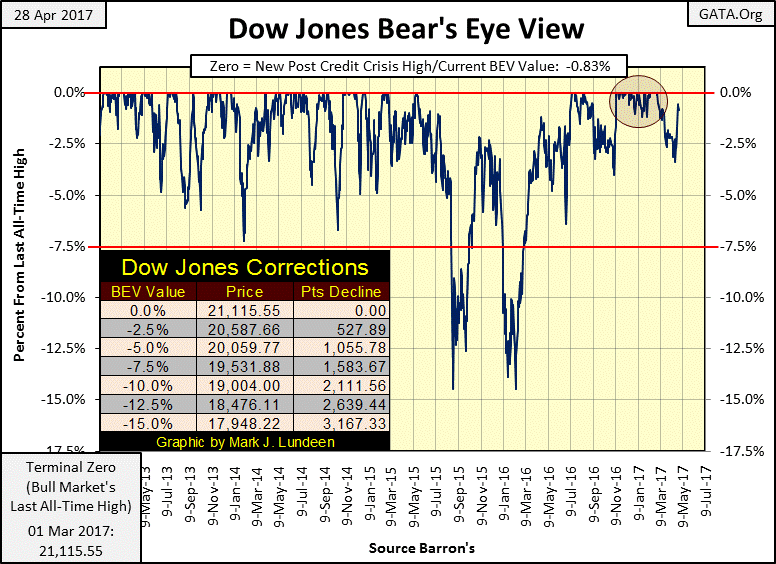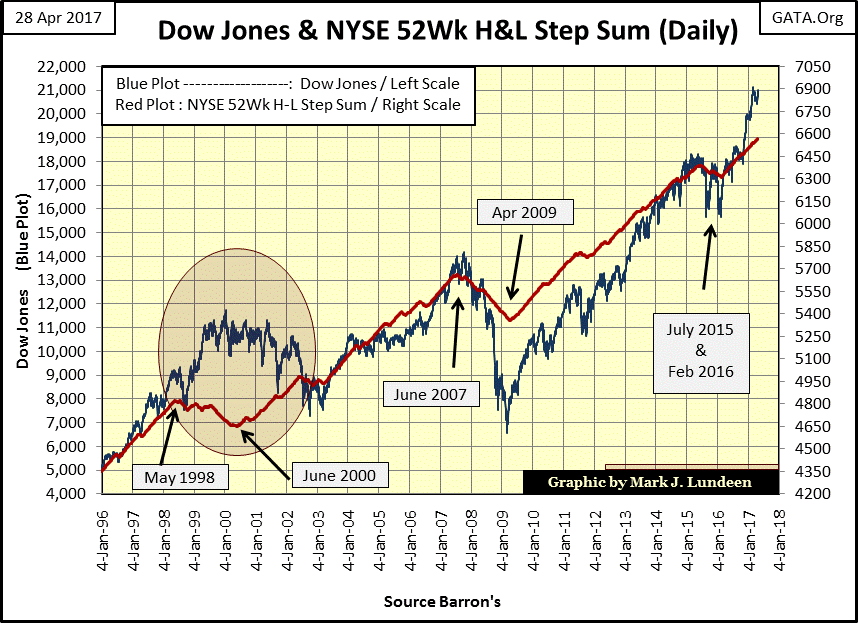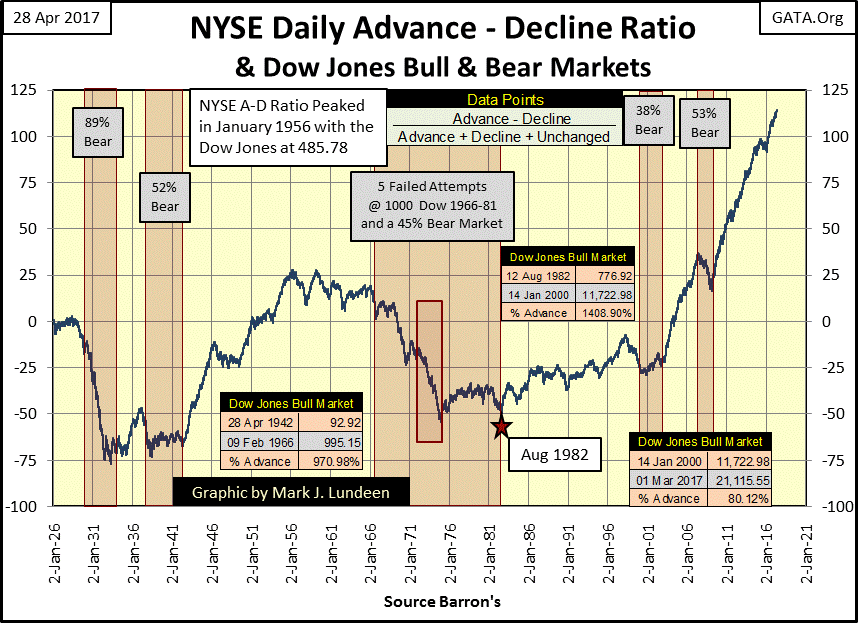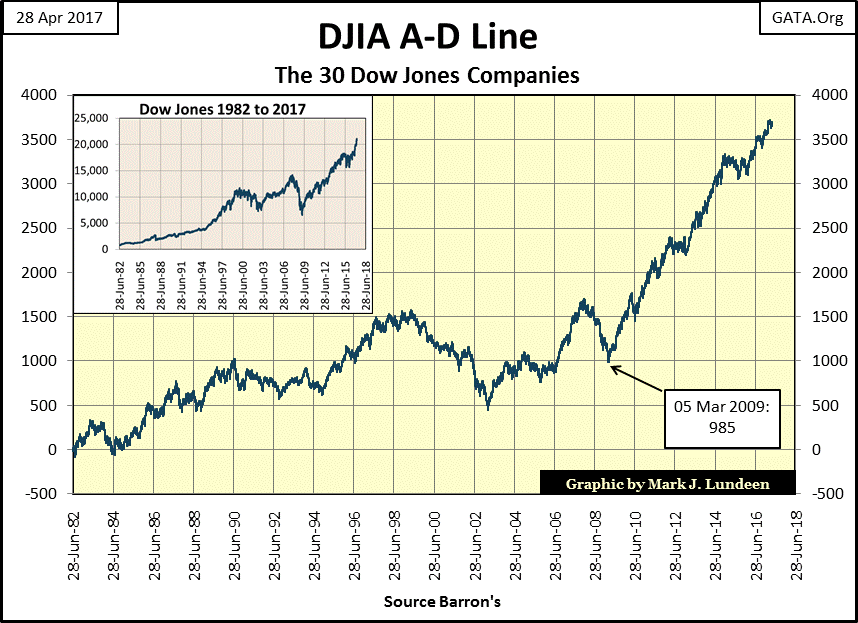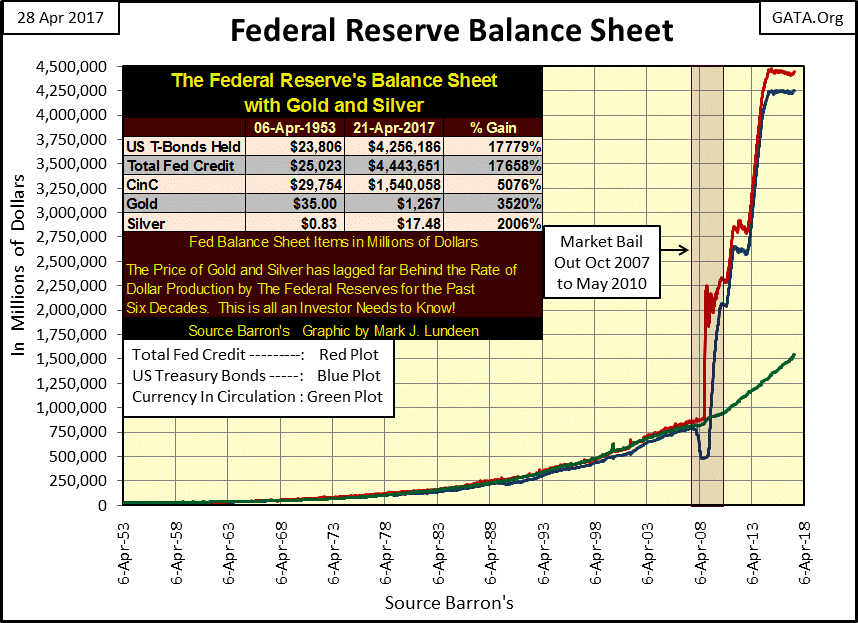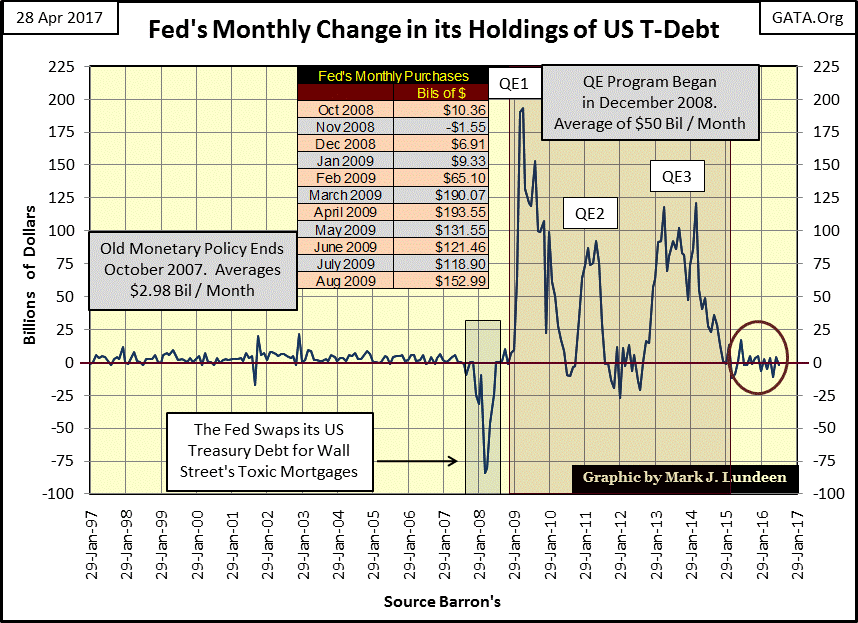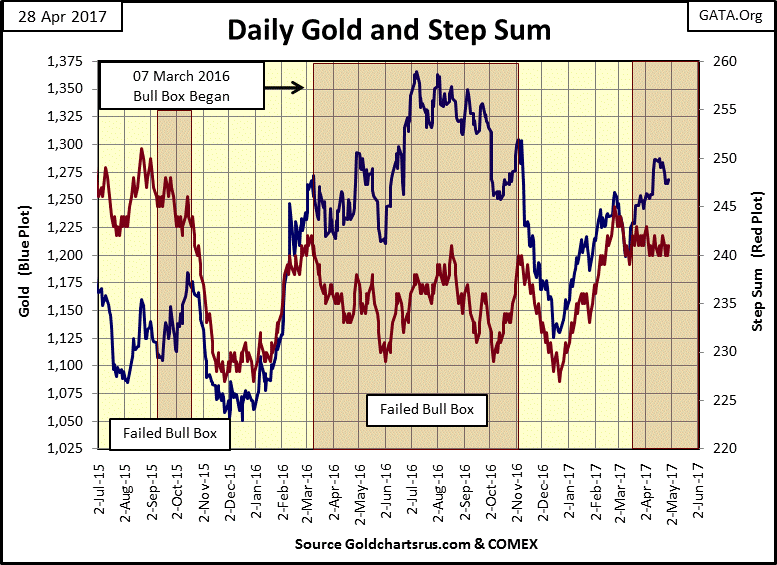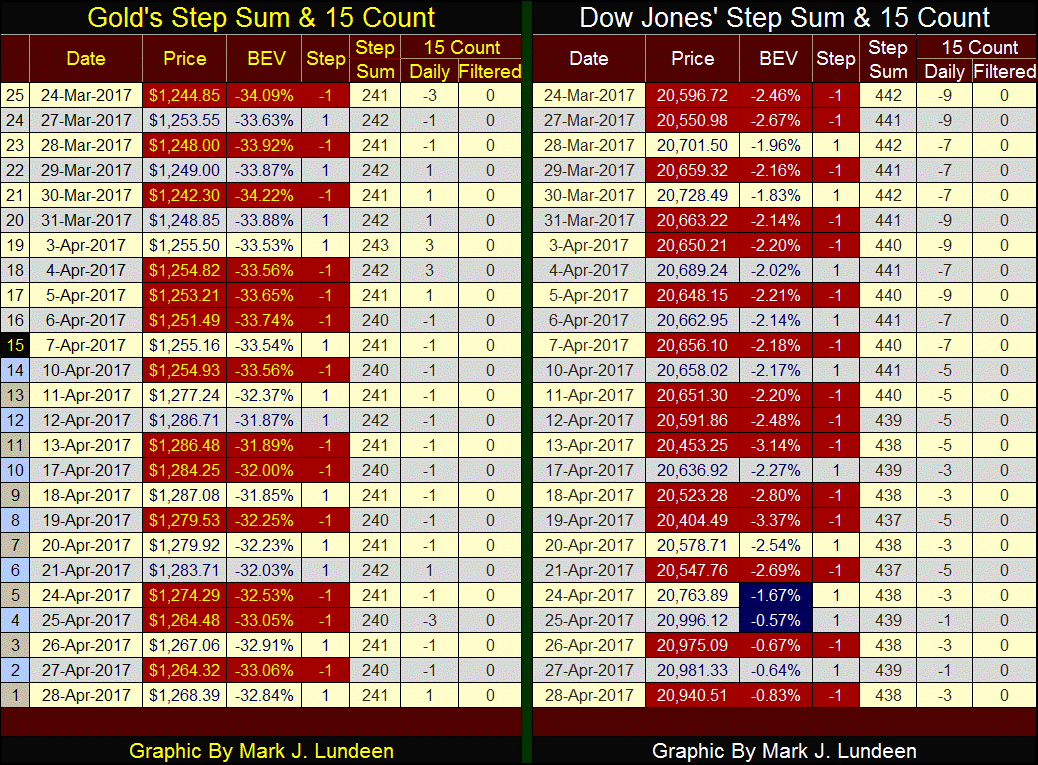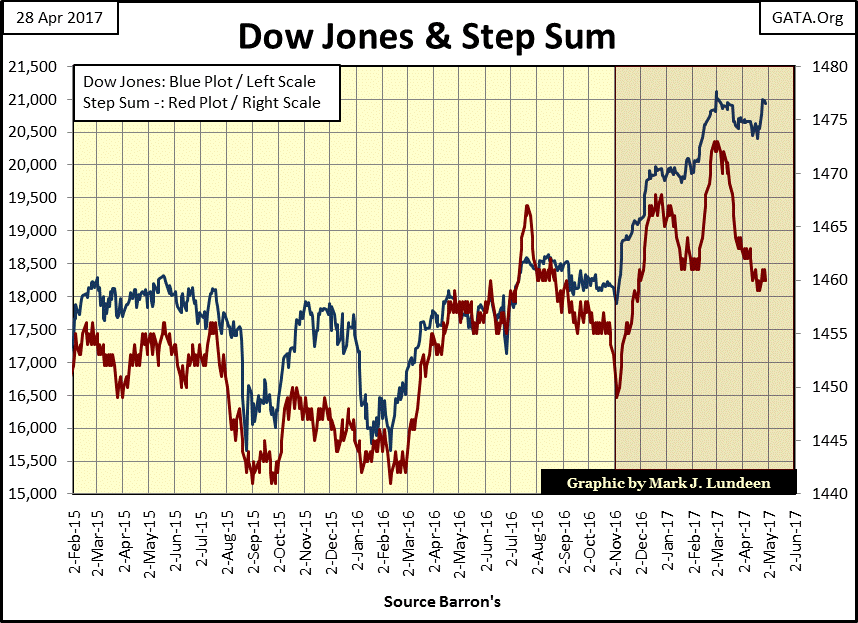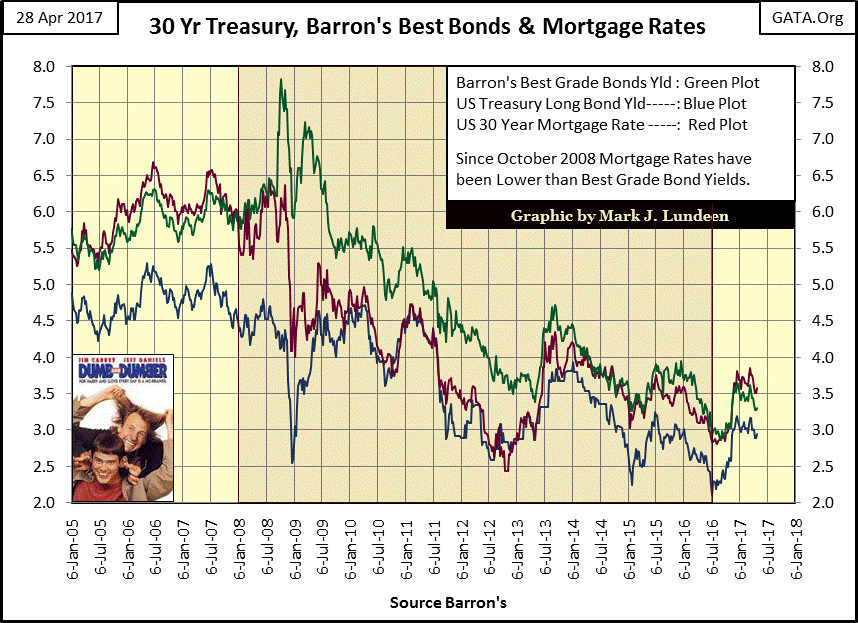Central Banks Are Monetizing Stocks And Bonds
Following this market is an exercise in frustration. Last week, the Dow Jones Index appeared ready to roll over. I expected the Dow Jones to be closer to its -5% line than its -2.5% line at the close of this week. But as you can see the Dow’s BEV chart below, it came charging back this week on Monday and Tuesday. However, I note the Dow failed to break above its last all-time high by Friday’s close. I find that interesting.
So, what should one do in a market such as this? First ask yourself what do want the market to do for you? Personally I like it when the market doubles my money. After eight years of rising valuations, seeing this market double your money in the next few years is unrealistic. What’s very possible is a large, double-digit percentage loss of one’s invested funds.
Look at the Dow Jones and the NYSE 52Wk Highs and Lows’ step sum below. The NYSE 52Wk High & Low step sum is constructed as follows, those days where there are more 52Wk Highs than Lows are given a +1. Day where there are more 52Wk Lows than Highs are assigned a -1. And like all step sums, the NYSE 52Wk Highs and Lows step sum is simply a single item A-D line using its daily +/-1s.
Except within the egg pattern, where the bull market of the 1990s became an exclusively high-tech bull market, a rising step sum for the NYSE 52Wk Highs and Lows data goes hand in hand with a rising Dow Jones. But eight years of more 52Wk Highs than Lows is a long time, which tells me this market is due for a significant correction.
The NYSE Advancing-Declining Ratio (below) going back to 1926 points out an oddity of the current market advance. Three major bull markets occurred during this span of time:
- 1942 to 1966
- 1982 to 2000
- 2000 to 2017
There are those who would question my using 14 January 2000 as the end of one bull market and the beginning of another, and I see their point. But my point is how the NYSE A-D Ratio behaved from 1982 to 2000, and how that behavior changed from 2000 to 2017.
From 1982 to 2000 (18 years), the Dow Jones advanced 1400% as the ratio only advanced some 25 points.
From 2000 to 2017 (17 years) the Dow Jones has advanced only 80% as the NYSE A-D Ration increased by over 125 points. Looking at the plot since 1926; never has the NYSE seen so many daily advances with so little effect on the Dow Jones.
Here’s the A-D line (not a ratio) for the thirty companies comprising the Dow Jones going back to 1982. From 1982 to today, there isn’t much difference from what we see above with the NYSE’s A-D ratio.
What should we make of this? I suspect this is yet another finger print left on the scene of the crime by the “policy makers” as they manhandled market valuations ever higher. They seem to always get what they want from the financial markets. I expect the “policy makers” are ultimately going to discover that they are not above the laws of nature, such as the law of diminishing returns.
Here are two articles reporting on central bank purchases of stocks and corporate bonds; one from Seeking Alpha the other from Market Watch.
https://seekingalpha.com/article/4064824-central-banks-massive-incursion-buying-stocks
After the big advances seen on Monday and Tuesday, with the Dow Jones closing just 3.88 from 21K and the NASDAQ closing over 6K for the first time in history, there has to be a reason. I doubt rising tensions of nuclear war flooded the market with buy orders, so central bank intervention in the market seems a reasonable assumption.
Here’s a chart from the Market Watch article. In 2006, during the heady days of the single family, sub-prime real estate boom, the combined totals of assets held as monetary reserves by the Federal Reserve, ECB, BoJ, BoE and SNB was a bit over $3 trillion. Eleven years later their totals are over $14 trillion, with $1 trillion added in the past twelve months.
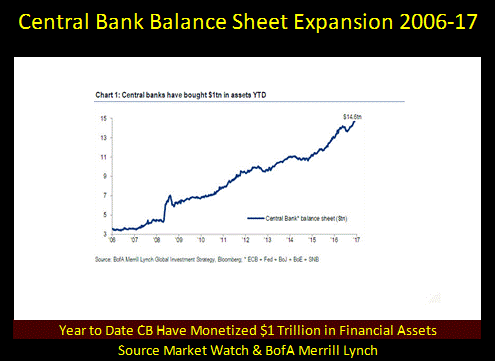
These guys know how to manage “monetary policy!” Here is the Federal Reserve’s balance sheet going back to 1953. The effect of the mortgage crisis on the Fed’s balance sheet was a historical event in central banking.
However, it appears the Federal Reserve hasn’t joined in on the inflationary merrymaking of the past year. Below we see the month over month monetization of US Treasury Debt going back to 1997.
It’s incredible how from 1997 to 2007 the Federal Reserve inflated huge bubbles in both the stock and real estate markets by monetizing on average only $2.98 billion dollars a month in the Treasury market. Also, from the perspective of the Fed’s balance sheet, the NASDAQ high-tech bear market (2000-2002) was a nonevent. Not so for the sub-prime mortgage bear market.
The sub-prime mortgage debacle was a market bubble leveraged to grotesque proportions. The banks, their regulators, and Congress encouraged known deadbeats, people with a solid record of being unemployed and not paying their bills, to assume six figure mortgages with little or no money down.
Not surprisingly, in 2007 when the mortgage market began to deflate, it threatened to take down the entire global banking / commercial payment system as America’s deadbeats walked away from trillions of dollars of their debt owed to the banks. All that plus the tens of trillions of dollars of interest rate derivatives that came into the money during the mortgage crisis, tens of trillions the big NY banks couldn’t make good on.
The severity of the situation the Federal Reserve found itself in is painfully apparent in the Federal Reserve’s balance sheet, as seen in the charts above and below.
Beginning in late 2007, the FOMC began swapping US Treasury bonds it held as dollar reserves for Wall Street’s non-performing mortgages. Then in early 2009 Doctor Bernanke began his first of three quantitative easings.
History records the Dow Jones bottomed on 09 March 2009 (6,547: a 54% bear market). What’s rarely, if never mentioned is how the Federal Reserve monetized over 190 billion dollars of the US national debt in both March and April of 2009 (see table in chart above). Had the FOMC not intervened in the financial markets with this massive “injection of liquidity”, the financial markets would have continued shedding market value as the global banking system closed for business. We would have seen a repeat of the 1930s, and for the same reason – malfeasance and incompetence at the highest levels of government and finance.
At the end of this week the Dow Jones is now 14,400 points from where it was eight years ago. Values in the real estate market are back where they were in 2006. But don’t take this as a sign of health in the economy. Wall Street’s and the economy’s reckoning with Mr Bear has only been postponed, accruing interest and penalty payments for the past eight years.
Why is that? Because no one has learned a damn thing since then! Long ago people knew that one got through life by hard work, thrift and savings. They learned that by surviving the depressing 1930s. The 1920s siren’s song of “buy now pay later” was rejected by most people by several generations of Americans.
That’s not true today! Be they members of Congress in matters of government, corporate officers managing industry and commerce, or humble wage earners budging their living expenses, it seems everyone today is as quick to take advantage of credit “at attractive rates” to leverage their income as when Alan Greenspan was Chairman at the Fed.
The credit cancer from the student loan program has now metastasized into the baby boomer generation.
https://www.infowars.com/student-loan-debt-now-big-problem-for-baby-boomers/
Then there are the sub-prime auto loans. I provide this link not to recommend or advise against this auto finance company, but to show that once again the Federal Reserve System is being reckless with the credit they are creating.

It’s just a matter of time before Mr Bear returns and marks to market many trillions of dollars of dubious credit instruments. But will the FOMC allow him to purge the economy of its unviable debts and inflated valuations in the financial markets? Or will we see the implementation of a QE4 in the chart above?
Like me, everyone will just have to wait to see how this resolves itself. But the smart money isn’t expecting the Dow Jones to double in value in either case.
However, if history is any guide (and it usually is) the future for gold, silver and the precious metals mining shares are brilliant. Though I can’t deny that currently they are having some difficulty.
Then again maybe I’m just being a big whiner. Looking at gold and its step sum below, there is actually nothing wrong with the chart. The bull box is still intact, and the price of gold is up nicely from its bottom of last December. But that doesn’t matter as I expect most of the gold bulls want the price of gold well above its highs of last summer. Damn it; we’re tired of waiting!
But students of the market, those who have been around the block a few times will tell you that human psychology and investment decisions don’t mix well.
Recall what the stock market felt like in January 2000 or October 2007. Those were times when the bulls in the stock market could get a good night’s sleep, but a year later how things had changed.
Look at the price of gold in the chart above. In December 2015 I was getting letters from my readers thanking me for my efforts, but all was lost as far as they were concerned when it came to gold and silver. Seven months later market psychology became euphoric, just before the big decline of last year.
Now in late April everyone is grumpy about gold, silver and the mining shares. I expect a year from now, anyone who buys at these prices will be very happy they did. Still the old monetary metals may see further declines in the weeks ahead.
Here is gold’s and the Dow Jones step sum tables. Gold lost $15 this week, but its step sum and 15 count ended where they were last week.
As per the articles on the central banks monetizing stocks and corporate bonds I posted earlier in this article, we see someone gave the Dow Jones a big shot of “liquidity” on Monday and Tuesday. There was no follow up in the following days. With the Dow Jones closing on Tuesday only 3.88 from breaking above 21K, it seems odd to me that the bulls would lose interest in this important psychological level so easily. But then there is always next week.
The Dow Jones and its step sum below looks good. The highlighted area isn’t a bull box. I placed it there to highlight the post November election advance. But since early March, the Dow Jones’ step sum has seen a big decline with little effect on the valuation of the Dow Jones. If this continues for another week or two I’ll have to place a bull box in this chart.
Dow Jones at 22,000? Don’t think it impossible if the “policy makers” make the effort.
So, don’t be surprised if the Dow has some surprises for us bears in the months to come. But my investment horizons go far beyond the next few months. Precious metals are coming off the bottom of a nasty four year bear market that ended in December 2015. The Dow Jones has been going up, really since August 1982 and that bullish trend’s days are numbered!
As aggravating as the current situation is for gold and silver, there are more technical and fundamental reasons to like the metals and their miners than stocks or bonds.
I’ve said it before, we may not see much in the way of excitement for gold, silver and the mining shares until the stock and bond markets begin to deflate as yields and interest rates return to where they were in early 2007.
Until then, gold’s and the Dow Jones step sum charts may both continue much as we see them at the end of this week.
Here’s some good news for my readers who have taken a speculative position in Eskay Mining. Jay Taylor interviews John Kaiser in the MP3 audio link below. It’s a bit technical, but seeing interest in this joint venture between Eskay Mining and Silver Standard Resources by well-known (and independent) exploration analysis such as Taylor and Kaiser is very encouraging.
http://jaytaylormedia.com/media/JohnKaiser20170424-2.mp3
Mr. Kaiser notes the joint venture with Silver Standard only commits a small portion of Eskay’s total holdings, leaving the bulk of its mineral claims free for future joint ventures with other major mining companies. Nice job Mac!
Here’s Mr. Kaiser with Jim Goddard.
Mr. Kaiser estimates if Silver Standard is successful discovering another Eskay Creek type of gold and silver deposit (of similar size), shares of Eskay Mining potentially could rise to C$5 with its current share structure and market prices for gold and silver. That’s a nice advance from its current price of C$0.36.
The potential of finding several Eskay Creek type deposits on Eskay Mining’s holdings is very real. On the discovery of a second Eskay Creek deposit Mr. Kaiser values Eskay Mining’s shares at C$20 - 26. And then there is the potential of finding other types of ore bodies in the remaining areas of Eskay Mining’s Cory zone.
Is this possible? Apparently Silver Standard believes it is, and is staking $11.7 million dollars of its own money to find out. Here’s a quote from Silver Standard’s chief geologist, Carl Edmunds:
"The SIB project is a very exciting exploration target in Northern Canada due to its higher grade drill results, the fact that these types of PME-VMS deposits often occur in clusters and this property is 4 kilometers along strike from the prolific Eskay Creek mine, which produced over 3 million ounces of gold and nearly 160 million ounces of silver between 1994 and 2008.”
And it’s not just geologists from Silver Standard who are optimistic about this project, and other areas of interest on Eskay Mining’s property. Charlie Greig has been Eskay Mining’s consulting geologist for years, because he wants to be in its exploration and development. Mr. Greig is a geologist with over thirty years’ experience, with extensive experience in grass root exploration, as well as taking early stage ore bodies to development. Silver Standard has hired Mr. Greig to oversee this extensive project.
Eskay Mining is an exploration company. No guarantees of performance can be made until the core drilling is completed and properly analyzed by the professional geologists employed by Silver Standard. After all this work and money they may find nothing, so I advise anyone interested in this project as a speculation to risk no more than 5% of their total capital.
Below is Eskay Mining’s press release for 26 April 2017, which notes the joint venture deal with Silver Standard is signed.
http://eskaymining.com/full_news.asp?nid=120&biraj=News%20Release
Drilling should commence June of this year, and hopefully good news for its shareholders by October.
Mark J. Lundeen
[email protected]






